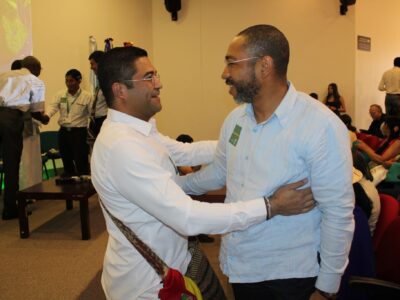
In Bangladesh, 75 percent of agricultural land is devoted to growing rice, which subsequently supports the staple-heavy dietary habits of the country. However, in addition to rice, Bangladeshi farmers often plant mung bean after their winter rice harvest. This practice allows them to add another crop to their rotation, which increases incomes and nutritional benefits as well as the amount of nitrogen that is recycled into the soil, improving future yields. Importantly, this practice also uses land and water that would otherwise go untapped, allowing farmers to produce more with less, which is one of the actions highlighted by the Food and Agriculture Organization (FAO) of the United Nations’ October 16 celebration of World Food Day.
From a nutrition perspective, cultivating short duration mung bean is particularly beneficial for smallholder farmers and represents an adaptation they will likely need to make in the face of climate change. To that point, increases in carbon dioxide are expected to lower the protein content of staple crops, which will be particularly detrimental to rice varieties in Southeast Asia. According to a study, higher carbon dioxide concentrations caused 18 rice cultivars grown in Southeast Asia to experience an average 10 percent decrease in protein, 8 percent decrease in iron, 5 percent decrease in zinc, and 13 to 30 percent decrease in four different B vitamins. For a population that receives nearly two-thirds of its daily energy from rice, according to the FAO, a further decrease in this staple crop’s nutrient content may increase Bangladeshis’ risk for micro and macronutrient deficiencies.
The Feed the Future Bangladesh Rice and Diversified Crops (RDC) Activity, funded by the United States Agency for International Development and implemented by ACDI/VOCA, promotes the cultivation of mung bean in the face of these expected changes. By partnering with private sector actors to increase farmers’ access to improved seed varieties, production and post-harvest management, and nutritional information about the importance of consuming mung beans, RDC is promoting climate-smart agricultural practices that also promote positive nutrition outcomes among rural smallholder farmers. Practices like this are important, as farmers continue to feel the pressures of climate change and its effects on nutrition and food security.
World Food Day is arriving on the heels of the United Nations’ recent Global Warming of 1.5°C report, which warns of food security implications, and another U.N. report stating hunger is on the rise for the third year in a row. To achieve the U.N.’s Sustainable Development Goal #2 of “Zero Hunger,” which is the theme of this year’s World Food Day, the number of undernourished people, currently at 821 million, would have to drastically decrease. Without changes, farmers will see lower crop yields and nutrient contents as global warming increases, due to increased temperatures, varying precipitation, extreme weather events, and high carbon dioxide concentrations, as reported by the U.N.’s global warming report.
Producing more with less is just one of the actions presented as part of World Food Day. Other actions include the following: (1) promote equality, (2) pursue resource efficiency, (3) adapt to climate change, (4) diversify crops, (5) unite as cooperatives, and (6) cut post-harvest loss. In Bangladesh and other countries, the adoption of good agricultural practices, like planting mung bean between rice and wheat harvests, will be help mitigate and combat the effects of climate change that smallholder farmers face disproportionately and that further threaten household food security.
Comments







